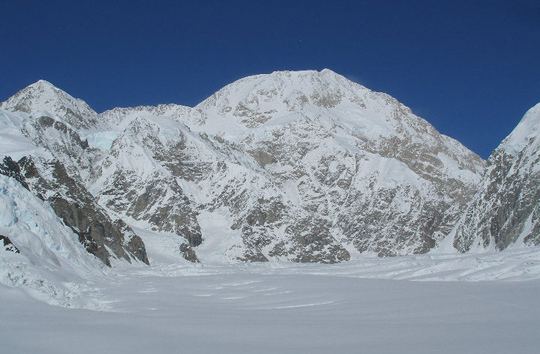
Denali (20,320′), as viewed from the West Buttress route. Recently, Swiss climber Beat Niederer was killed and several others were severely injured on the West Buttress route. Niederer died after sustaining injuries in a fall, and then spending a night exposed to winds of more than 60 mph at 18,000 feet. Jeremiah O’Sullivan of Ireland suffered a broken leg and frostbite from spending a night out at 19,500 feet, but was successfully rescued by helicopter. Two other climbers were evacuated from 17,200-foot camp with frostbite following the accident. [Photo] Keese Lane
One climber has died on the West Buttress of Denali and another four are injured after a series of accidents high on the mountain. All of the climbers have been removed from the mountain, but the exact details of the accident are still being determined.
On May 11 a six-man team from Mountain Trip began their final push for the summit of Denali (20,320′), North America’s highest peak, via the West Buttress route. The team consisted of Tony Diskin, Jeremiah O’Sullivan, Beat Niederer and Lawrence Cutler, with their two guides Dave Staeheli and Henry Munter. The team left the 17,200-foot high camp under conditions described as “perfect” on May 11 despite a weather forecast that predicted wind (one other team member chose to remain at the high camp because of this forecast). Somewhere near Denali Pass (18,200′), Tony Diskin decided to turn back. Diskin wore gloves rather than mittens, and suffered frostbite on his hands. He descended back to the 17,200-foot camp with assistant guide Henry Munter where they met the other member of their party and descended to the 14,200-foot camp.
O’Sullivan, Cutler and Niederer continued upward with Staeheli, summiting the mountain in the late afternoon or early evening. The foursome was descending near “Pig Hill” at 19,500 feet when O’Sullivan tripped and fell, pulling the team down at least 300 feet of hard glacial ice. It was “immediately apparent” that O’Sullivan had broken his leg, but in the fall Staeheli also broke a rib and Niederer dislocated a shoulder and possibly sustained other injuries. Cutler was relatively unscathed. Staeheli, realizing that he could not rescue the group in its present condition alone, attempted to radio for help, but could not get a clear signal. He then attempted to call out on a satellite phone, but found that the antennae was broken. Staeheli sent Niederer and Cutler with the radio down to the Football Field (a flat area around 19,500 feet) in hopes that they would be able to call for help. Having stabilized O’Sullivan, Staeheli gave O’Sullivan his parka and placed the injured climber in a bivy sack. He then attempted to drag the immobile climber down to a site better situated for helicopter rescue, but gave up after several hundred feet.
At this point, winds were still light (20-30mph) and Staeheli believed he could reach the 17,200-foot camp in 1.5 hours and from there organize a rescue. Staeheli began to descend with Cutler and Niederer, leaving O’Sullivan at 19,500 feet. The rope remained above at the site of the fall and, by this point, Staeheli’s hands were too frozen to have been able to manipulate it. Staeheli descended with Cutler and Niederer who was moving slowly. Around 18,500 feet near a place called Zebra Rocks, Niederer was separated from Cutler and Staeheli. By now the air temperature was around minus 20 degrees Fahrenheit and the winds were blowing at 20-30 mph. Staeheli briefed Cutler on how to descend the rest of the way to high camp, and then took off on his own. Soon after Staeheli reached high camp the wind speed dramatically increased to more than 60 mph. Cutler managed to reach the camp despite the winds but Niederer’s location and condition was unknown. Pat Ormond, the leader of a team that had summitted earlier that day, and Mountain Trip guide Jack McGee aided the two climbers and initiated the rescue process. But the winds prevented rescuers from leaving the high camp. At this point the accident timeline had pushed into the morning of May 12.
An Alaska Air National Guard HC-130 airplane was sent to assist, and was able to spot O’Sullivan at 19,500 feet, who was waving his arms to attract attention. The HC-130 was not able to find Niederer. The strong winds kept helicopter flight below 14,200 feet. By 5 p.m. on the 12th, nearly 21 hours after the fall, the winds slowed and a NPS helicopter and the HC-130 were able to fly over the mountain. The helicopter located Niederer near 18,000 feet and O’Sullivan near 19,500 feet. The helicopter returned and lowered a basket for O’Sullivan to climb into, and then transported him to the Kahiltna base camp where a LifeMed air ambulance carried him to a hospital in Anchorage. The NPS helicopter then returned with a ranger, who lowered down and attached Niederer to a canvas sling. At no point during the flight did Niederer show any signs of life. A CH-47 “Chinook” was waiting at the Kahiltna base camp to take Niederer for further medical assessment. NPS staff on board the Chinook confirmed that Niederer was dead, though the exact cause of death remains unknown. On May 13, Staeheli and Cutler were both helicoptered from high camp and treated for frostbite in addition to Staeheli’s broken rib.
All quotes are from Todd Rutledge of Mountain Trip unless otherwise noted. At this time new events are still coming to light and the staff of Alpinist.com will continue to update this post as we receive new information. -ED